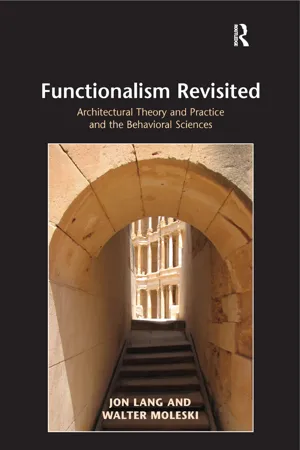
Functionalism Revisited
Architectural Theory and Practice and the Behavioral Sciences
- 376 pages
- English
- ePUB (mobile friendly)
- Available on iOS & Android
Functionalism Revisited
Architectural Theory and Practice and the Behavioral Sciences
About this book
A range of current approaches to architecture are neglected in our contemporary writings on design philosophies. This book argues that the model of 'function' and the concept of a 'functional building' that we have inherited from the twentieth-century Modernists is limited in scope and detracts from a full understanding of the purposes served by the built environment. It simply does not cover the range of functions that buildings can afford nor is it tied in a conceptually clear manner to our contemporary concepts of architectural theory. Based on Abraham Maslow's theory of human motivations, and following on from Lang's widely-used text, Creating Architectural Theory: The Role of the Behavioral Sciences in Environmental Design, Lang and Moleski here propose a new model of functionalism that responds to numerous observations on the inadequacy of current ways of thinking about functionalism in architecture and urban design. Copiously illustrated, the book puts forward this model and then goes on to discuss in detail each function of buildings and urban environments.
Frequently asked questions
- Essential is ideal for learners and professionals who enjoy exploring a wide range of subjects. Access the Essential Library with 800,000+ trusted titles and best-sellers across business, personal growth, and the humanities. Includes unlimited reading time and Standard Read Aloud voice.
- Complete: Perfect for advanced learners and researchers needing full, unrestricted access. Unlock 1.4M+ books across hundreds of subjects, including academic and specialized titles. The Complete Plan also includes advanced features like Premium Read Aloud and Research Assistant.
Please note we cannot support devices running on iOS 13 and Android 7 or earlier. Learn more about using the app.
Information
Part I
Introduction: Architectural Theory and Functional Theory

Tom Wright of WS Atkins PLC, architect.
DSA [Dubai South Africa], architects.
1
The Inheritance: Architectural Practice and Architectural Theory Today
He who loves theory without practice is like a sailor who boards a ship without a rudder and a compass.
The Intellectual Heritage
Early Modernist Schools of Thought
The First Generation of Rationalists
The Second Generation of Rationalists
Table of contents
- Cover
- Half Title
- Title Page
- Copyright Page
- Table of Contents
- List of Figures
- List of Tables
- About the Authors
- Preface
- Part I Introduction: Architectural Theory and Functional Theory
- Part II Creating a Theory of Functionalism
- Part III The Functions of the Built Environment: Theory and Practice
- Part IV Externalities: Buildings in Context
- Part V Conclusion
- References and Bibliography
- Index